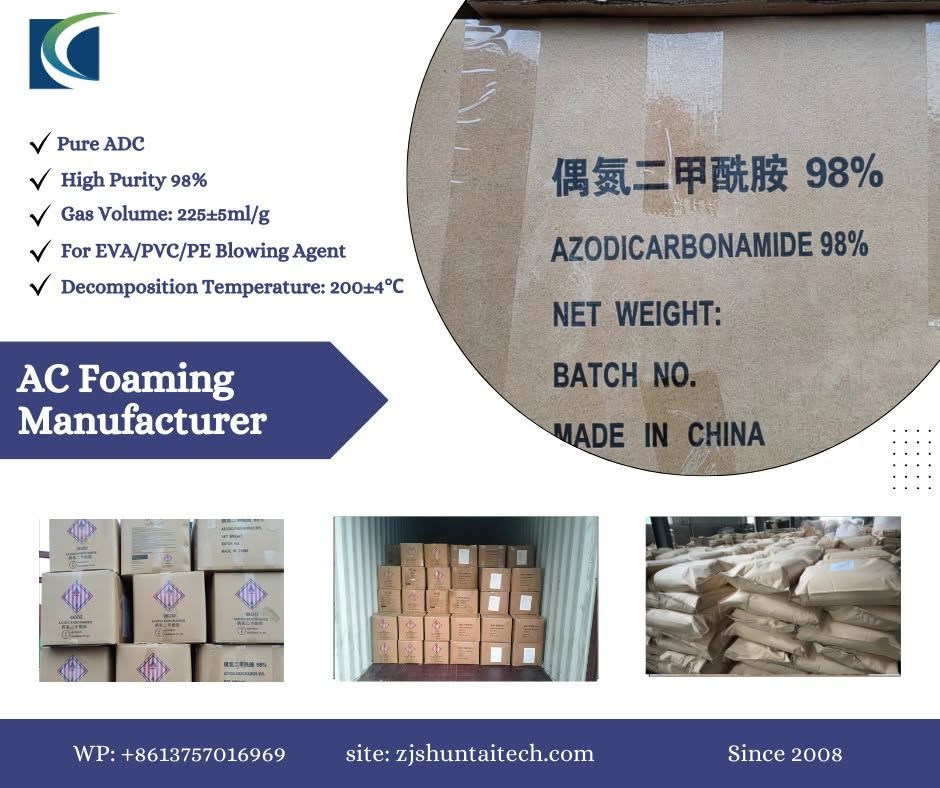AC Azodicarbonamide (ADCA), commonly known as AC blowing agent, is a chemical blowing agent widely used in the plastics and rubber industries. It alters the physical properties of materials by releasing a gas when heated, causing the material to form a foam structure. From yoga mats to shoe soles, AC blowing agents are ubiquitous and bring a lot of convenience to our daily lives. However, as a chemical substance, the use of AC foam also carries certain safety risks. Therefore, it is important to know and understand the correct safety practices. The purpose of this article is to provide you with a comprehensive safety guide to help you stay safe when using AC blowing agents.

AC Blowing Agent is a yellow-orange crystalline powder, odorless, with the chemical formula C2H4O2N4. Its primary function is to generate gas during the processing of plastics and rubber to form a uniform foam structure.
Efficient gas release
Each gram of ADCA can release about 220-250 ml of gas, realizing good foaming effect.
UniformityUniform gas release during decomposition, forming regular bubble structure and improving product quality.
Thermal stabilityGood thermal stability in the range of 200-220°C, not easy to decompose in advance.
Wide processing adaptability Applicable to a variety of plastics and rubber processing temperature.
Excellent physical and mechanical properties
Forms a stable homogeneous structure and improves the elasticity and thermal insulation properties of the material.
Compatibility and versatility
Can be used with a variety of polymer materials (such as PVC, EVA, PE, PP, rubber, etc.), suitable for a variety of processing processes (such as injection molding, extrusion, blow molding, etc.).
Environmental and economic
High gas generation reduces usage and production costs, and waste disposal is relatively simple.
Safety and controllability
The decomposition temperature can be controlled, and the toxicity of the gas generated is low.
Potential Risks and Hazards
Despite the many advantages of
AC blowing agent, there are still potential risks and hazards in its use:
Dust Inhalation
Dust generated during operation may cause irritation to the respiratory system.
Skin and Eye Contact
Direct contact may cause irritation or allergic reactions.
High Temperature Decomposition
Decomposition at high temperatures may release toxic gases such as carbon monoxide.
Improper Storage
Storage in a hot or humid environment may cause decomposition or deterioration.
Safe Handling and Processing
In order to minimize risk, the following are some key safe handling and disposal measures:
Storage:
Store
AC Blowing Agent in a cool, dry, well-ventilated area away from heat sources and direct sunlight.
Ideal storage temperature should be less than 30°C.
Keep containers sealed to prevent moisture from entering.
Use moisture-proof packaging and temperature-controlled storage facilities.
Ventilation:
Install local exhaust ventilation (LEV) systems in processing areas to remove dust particles from the air.
Take dust control measures, such as using anti-static equipment and controlling airflow, to reduce dust accumulation.
Personal protective equipment (PPE):
Wear respirators equipped with dust filters to prevent inhalation of dust.
Wear protective gloves, goggles and clothing to prevent skin and eye contact.
Conduct regular PPE training and maintenance.
Temperature monitoring:
Strictly control temperature during processing to prevent overheating and rapid gas release.
Use a temperature monitoring system and automatic shutdown controls to prevent accidents.
Emergency Response and Handling
To deal with possible emergencies, the facility should have a clear emergency response plan:
· Fires: Prepare fire extinguishers and other firefighting equipment and conduct regular training.
· Chemical Spills: Prepare spill handling tools and materials and conduct training.
· GAS RELEASE: Ensure adequate ventilation and have breathing equipment available.
· First Aid: Prepare first aid kits and train employees to administer first aid.
· Safety Drills: Conduct regular safety drills to ensure employees are familiar with emergency response procedures.
Frequently Asked Questions (FAQ)-Shuntai
Q: What are the storage conditions for AC Blowing Agent? o A: It should be stored in a cool, dry and well-ventilated place at a temperature below 30°C and keep the container sealed.
·
Q: How to dispose of AC blowing agent waste? o A: It should be disposed of in accordance with local regulations to avoid pollution of the environment.
·
Q: What PPE do I need to wear when using AC blowing agent? A: Respirators, protective gloves, goggles and protective clothing are required.
Conclusion
AC azodicarbonamide blowing agent is an important industrial raw material, but safety must be given high priority in its use. By following proper operating practices, wearing appropriate PPE and having a well-developed emergency response plan, we can minimize safety risks and ensure production safety.
Our company has been committed to the production and research and development of
AC blowing agent since 2008, with rich industry experience and professional knowledge. We always adhere to the principle of “quality first, safety first” to provide customers with high quality products and perfect service. Our R&D team is constantly innovating and is committed to developing safer and more efficient foaming agent products. Please feel free to contact us for more information about
AC Blowing Agent.
Email:shuntaichenzh@gmail.com
Site:
zjshuntaitech.comEnquiry:
+8613757016969
